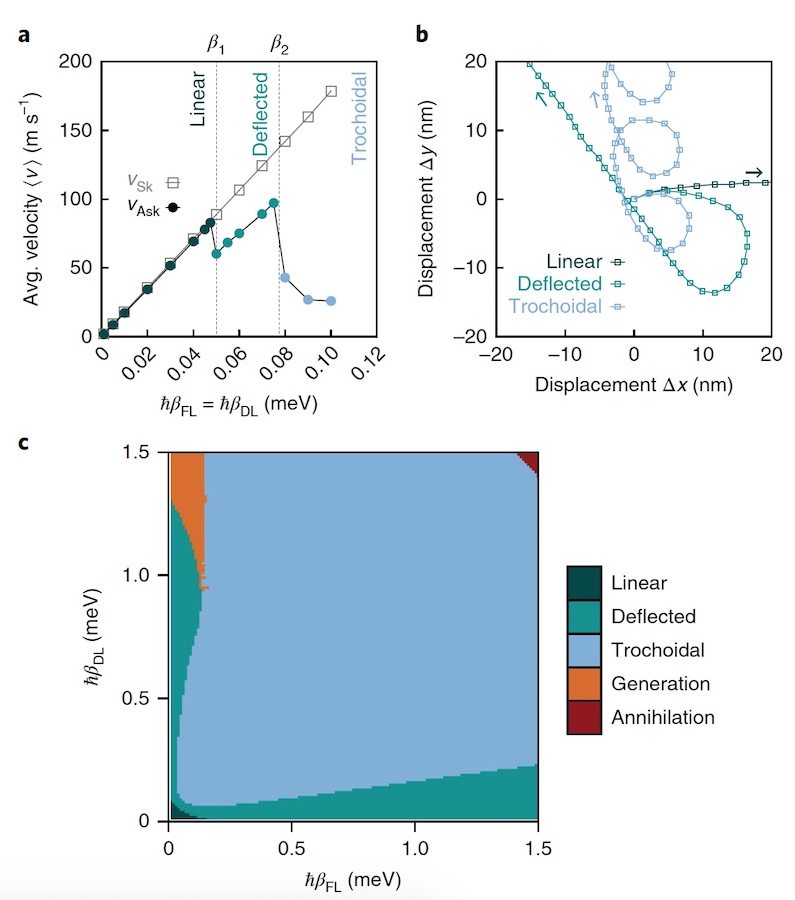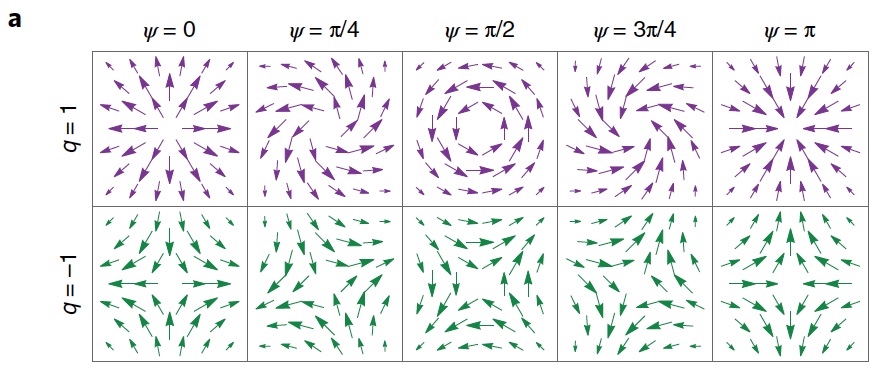A pair of skyrmion-antiskirmion as a possible future of data storage

Modern technology seems ordinary and familiar to us. However, the mere thought of such things about 50 years ago seemed something unreal and futuristic. Today, these epithets have retained their popularity, for scientists continue to expand the boundaries of our understanding of the world.
The future of information technologies depends not only on the improvement of the existing components of this integral part of human life, but also on the search for new materials, techniques, techniques and other things. Today we will deal with one very curious study of magnetic skyrmions and anti-scyrmions. What is it, why is it and how can IT improve in the future? For the answers, we dive into the scientists' report. Go.
')
What is a magnetic skyrmion?
For a start it is worth recalling that the atoms of magnetic materials with their own magnetic moment of the electron, behave like magnets, in simple words. When matter is magnetized, the spins of atoms line up in a certain way, which makes this substance a magnet.
In 2009, researchers discovered a very fascinating feature of individual atoms. Their backs curled into funnels (whirlwinds). Such a structure was named Skyrmion, in honor of the British physicist Tony Skyrme, who back in 1962 described a mathematical model of vortex spins.

Image a - skyrmion "hedgehog", b - spiral-shaped skyrmion.
One of the important IT features of skyrmions is their topological stability. The bottom line is that any disturbance can change the direction of the spins, but the twist will remain the same. Thus, it is possible to store information in binary form: 0 - there is no skyrmion, 1 - there is a skyrmion. And given the nanometer size of such structures, the density of information storage can also increase significantly.
Coming out of this information, the existence of anti-scyrmiones was also assumed, whose topological charge would be opposite to ordinary skyrmions.
Two-dimensional spin structures have a non-trivial topology, which is responsible for their specific level of stability. Such structures are characterized by topological charge:

where m = m (r, t) is the direction vector of the magnetic moments in time and space.
Skyrmions (q = 1 ) and anti-scyrmions ( q = -1 ) have opposite charges and can occur in pairs if a homogeneous state deformation occurs ( q = 0 ). The description of the dynamics of skyrmions and anti-skirmions can be approximated if the core is considered stationary, which reduces the required number of variables to describe their movement.
The formula below describes the damped gyrotropic movement of the position of the nucleus (X) of skyrmions and anti-scyrmions in response to the applied force (F):

G, equal to -qG0z, is a heating detector;
α is the damping constant;
D0 is a structural factor.
The dynamics in the above equation are non-Newtonian, and therefore the gyrotropic response depends on q and dictates the direction in which the core moves.
Base study
In their study, scientists describe the dynamics of skyrmions and antiskirmions in ultrathin ferromagnetic films. The occurrence of spin-orbital moments, which can lead to the appearance of a trochoidal motion and the generation of a skyrmion-anti-scyrmion pair, was detected. Such a dynamics is caused by the deformation of the nucleus, which in turn leads to time-dependent helicity, which controls the movement of the nucleus of the skyrmion and the anti-scyrmion.

Example of trochoidal movement (elongated cycloid)
Using simulations of atomic spins, predictive modeling with the reduction of variables and machine learning algorithms, a dynamic phase diagram was computed that predicts how spin-orbit moments can control the type of motion and also lead to the formation of skyrmion arrays by introducing anti-scyrmions.
Simulations of atomic spin dynamics

Image number 1
The basis of the study was a substrate of normal metal and a layer of ferromagnetic transition metal (image 1a ). An example of such a substance is the PdFe / Ir (111) alloy, in which persistent antisymmetric exchange in iron ( Fe ) monolayer is caused by an interphase bond with a strong spin-orbit interaction in an iridium ( Ir ) substrate. This allows individual skyrmions to exist in a metastable state.
It has also been found that anti-syncrmic states can also be metastable when frustrated exchange interactions in thin films or a bulk sample are taken into account.
In image 1b, it can be seen that the usual and antisymmetric exchange interactions have sixfold symmetry, which is associated with the surface of iridium. If the power of the antisymmetric exchange interaction is reduced, then an equilibrium state can be reached for skyrmions ( 1c ) and anti-scyrmions ( 1d ).
The researchers note that the intraplanar current must pass through a ferromagnetic metal and a substrate of normal metal. However, in this case, most of the current passes only through the iridium substrate, since the resistivity of the layer is much higher for ultrathin ferromagnets.
1e represents the hexagonal lattice structure and the direction of the antisymmetric exchange interaction vectors, which were used to maintain the antiscirmional state.
1f is the equilibrium state of a skyrmion with antisymmetric exchange interaction, and the 1g image shows the equilibrium state of an anti-scyrmion with antisymmetric exchange interaction.
Spin dynamics and formation of a pair of skyrmion-anti-scyrmion

Image number 2
Image 2a shows changes in the average velocity 〈v〉 of skyrmions and anti-scyrmions as a function of the spin-orbit moment, where β FL = β DL . For anti-scyrmiones, three propagation modes were defined: linear movement at low current, deflected movement at medium current, and trochoidal movement at high current.
It should be noted that the rate of anti-scyrmion does not increase parallel to the spin-orbit moment, as it happens in skyrmions.
Calculations of the behavior of skyrmions made it possible to make an assumption regarding the trajectory of movement of anti-scyrmions, as shown in image 2b . Three trajectory options for the three modes. Arrows indicate the direction of the motion vector.
Modern abstractionism in the image 2c is a phase diagram of different behavior for different values and ratios β FL (force of field torque) and β DL (power of "damped" torque). Thanks to machine learning algorithms, three main types of trajectories (linear, deviated, and trochoidal) were identified, which cover a wide range of speeds and directions of propagation.
Trochoidal and rejected trajectories arise due to the deformation of the core of anti-scyrmion. It is the trochoidal trajectory that occurs with a very wide range of values of the spin-orbit moment.

Image 3a
The deformation of the nucleus is characterized by the appearance of the dynamic variable ψ (t) , which denotes the helicity of the skyrmion and the anti-scyrmion (image 3a , where q = 1 are skyrmions, and q = -1 are anti-scyrmions).
The variable ψ for skyrmions describes a continuous transition between the states of Bloch and Neel of opposite chirality, and for anti-scyrmions, the rotation of the axes of Bloch and Neel.
In the system created by the researchers, the deformation of the nucleus is due to the spin-orbit moment, which leads to a tilt in the magnetization in the film plane, which is characterized by the amplitude η and the azimuth ϕ t .
For external spins, the slope is the same all the time, but inside the anti-scyrmion core, it varies with.
It was found that with a small β FL and a large β DL a new dynamic state arises, leading to the formation of a skyrmion-anti-scyrmion pair. When the anti-scyrmion passes along its trochoidal trajectory, it is accompanied by a strong deformation (elongation of the nucleus). This is seen in image 4a (specifically at t = 3 ps). Further, this elongation, which is a skyrmion-anti-skirmion pair, is separated from the core itself.

Image number 4
Image 4b shows the density of the topological charge of this process. However, the existence of a pair is not constant. Over time, the pair begins to decay, since the spin-orbit moments “force” the skyrmion and the anti-scyrmion to move in different directions. The skyrmion moves along a linear path from the point of pair formation. The anti-scyrmion begins to move along the trochoidal trajectory, which leads to the formation of a new pair (image 4c ). This process is repeated again and again, and this suggests that it is possible to create from a single anti-scyrmion not only one single pair, but many new pairs.
Antisymmetric exchange interaction
Earlier we already learned that the rejected and trochoidal trajectories were found only in antiskirmions. This is due to the fact that the barrier of internal energy (with equal antisymmetric exchange interaction, then AOB) of the skyrmion is much higher than that of the antiscyrmion. That is, the asymmetry between opposite topological charges depends on the AOW, and not on the charge itself.

Dynamics of skyrmions and anti-skirmions in the absence of AOB
The importance of AOB is clearer and easier to show if it is not in the system. In this case, the skyrmions and anti-scyrmions will continue to maintain the metastable state due to the frustrated exchange interaction, which leads to a state of equilibrium ( a and b in the image above). It turns out that the system has no interaction between the skyrmion and the anti-scyrmion, which leads to the destruction of the states of Bloch and Neel. As a consequence, the profile shown in the image is the only way to realize the metastable state of the skyrmion, image b is the metastable state of the antiscirmion.
In the image with, we see that there is a circular motion with opposite direction for opposite topological charges.
As a conclusion, the emergence of skyrmion-anti-scyrmion pairs without antisymmetric exchange interaction is impossible.
The report of scientists reveals much more fully the peculiarities of their research, therefore, I highly recommend it.
In the process of working on the material, I found a very impressive work “Introduction to spin torques and spin-orbital moments in metal layers”. Maybe someone will come in handy, therefore leave a reference.
Epilogue
This study, according to scientists, showed a rich dynamics, possible at different spin-orbit moments in ultrathin ferromagnetic films. The most important points of their work, they call a description of the process of a pair (the reverse of the vortex core) and the comparison of skyrmions and other phenomena of micromagnetism.
This work will unambiguously become the basis for further research, the purpose of which will be the realization of the possibility to choose the necessary orientation of the surface or interface for their adaptation to certain dynamic properties. This will be a new milestone in materials science, given that previously more attention was paid only to the quantitative determination and control of linear motion trajectories for memory and logical applications based on skyrmions.
This study demonstrates the possibility of the existence of several different dynamics at once in different metastable states within a single material system.
As a result, such developments may become the basis for the creation of new types of storage and information processing devices, which would entail the most revolution in the world of information technologies.
Thank you for staying with us. Do you like our articles? Want to see more interesting materials? Support us by placing an order or recommending to friends, 30% discount for Habr users on a unique analogue of the entry-level servers that we invented for you: The whole truth about VPS (KVM) E5-2650 v4 (6 Cores) 10GB DDR4 240GB SSD 1Gbps from $ 20 or how to share the server? (Options are available with RAID1 and RAID10, up to 24 cores and up to 40GB DDR4).
3 months for free if you pay for new Dell R630 for half a year - 2 x Intel Deca-Core Xeon E5-2630 v4 / 128GB DDR4 / 4x1TB HDD or 2x240GB SSD / 1Gbps 10 TB - from $ 99.33 a month , only until the end of August, order can be here .
Dell R730xd 2 times cheaper? Only we have 2 x Intel Dodeca-Core Xeon E5-2650v4 128GB DDR4 6x480GB SSD 1Gbps 100 TV from $ 249 in the Netherlands and the USA! Read about How to build an infrastructure building. class c using servers Dell R730xd E5-2650 v4 worth 9000 euros for a penny?
Source: https://habr.com/ru/post/420955/
All Articles